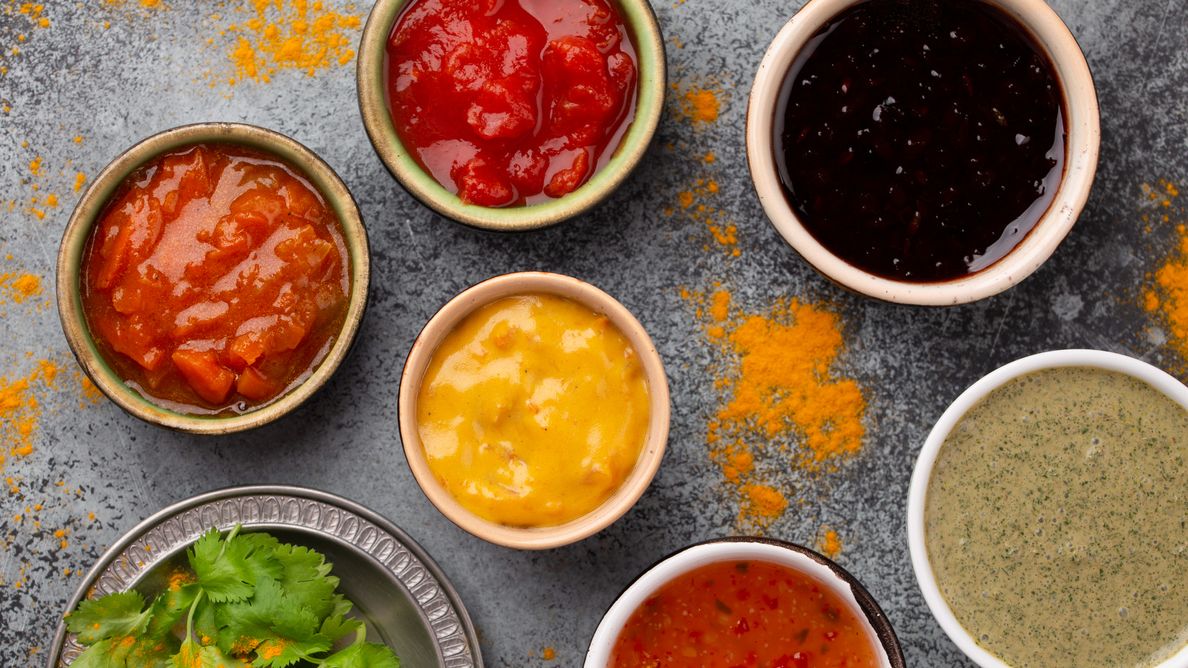It peps up any meal, adds zest to a plain dal and no chaat dish can exist without it.
Served at the side of the plate, just a spoonful, chutney is an integral part of any Indian meal, this spicy accompaniment, fires hunger and then satisfies it.
Memories about food are never about calories or health benefits. They are always about the satiation of relishing a meal. So, you remember and crave for the college canteen green chilli chutney, your grandma’s mango chutney or some onion chutney you ate somewhere, sometime at an obscure dhaba.
Chutneys must have been invented before pickles as pickling follows a complex process. The primitive man must have realized that crushed berries and fruits tasted good with food and thus chutneys may have happened.
Why Eat a Chutney?
Grinding a few ingredients with a pinch of salt and dash of spices, fresh chutneys are easy to make.
Rich in vitamins, antioxidants, and minerals, these condiments enhance appetite, reduce inflammation, can cure dyspepsia, and are good for detoxification.
According to Ayurveda, chutneys can stimulate the digestive fire or Agni and improve digestion.
Grinding Story
A few years back, chutneys were either crushed or pounded with stone.
Today, electrical blenders have replaced these stone tools. Grinding in mixers alters the taste of the ingredients due to the generation of heat.
Hand-pounding keeps the flavours intact as grinding happens without the generation of heat by releasing the oil and fibre imparting a tangy taste.
Here are some chutney recipes for you to try:
1. Ber Chutney
Ber or Indian jujube (Ziziphus mauritiana) is a fleshy fruit with a pleasant aroma. It contains thiamine, riboflavin, niacin, traces of calcium, iron and phosphorous. It is also rich in fibre.
Ingredients
1 cup ber fruit pulp
4-5 garlic cloves
½ tsp chilli powder
½ tsp cumin seeds
½ cup jaggery
¼ cup roasted sesame seeds
½ tsp of black salt
Method
Grind Ber pulp, garlic cloves, sesame, and cumin seeds. Add jaggery, chilli powder and black salt and grind well.
You can make a dry chutney by sun drying the ber fruit.
Firstly, hand pound the dry berries. Sieve to remove the stones and hard particles. Grind finely.
Add roasted cumin seeds, black salt, and chilli powder.
Store in an airtight container.
2. Potato Chutney
This chutney is to be made only with fresh potatoes in season. Do not make it with sprouted potatoes or with a greenish/blackish tinge.
Ingredients
2 medium potatoes
½ tsp chilli powder
1 tsp coriander seeds
½ tsp cumin seeds
1 tbsp lemon juice
Salt to taste
1 tsp oil
Method
Wash the potatoes by gently rubbing to remove the dirt.
Apply a little oil to the potatoes and roast on a griddle. Keep turning until the potatoes are cooked.
Remove the skin and cut into chunks. In a mortar add coriander and cumin seeds and grind coarsely, add potatoes, chilli powder.
Grind coarsely.
Add salt and lemon juice and mix.
3. Karonda Chutney
Karonda or Carissa carandas is a hardy and a drought-tolerant plant that grows in the Himalayas, Siwalik hills and the Western Ghats. It contains calcium, phosphorous, vitamins A and C. The fruit is good for digestion and stomach ailments.
Ingredients
100 gms Karonde
1 tsp chilli powder
5 tbsp sugar
Salt to taste
Method
Remove the stones from the karonda and chop into pieces. Blend or grind. The chutney is ready. It tastes great with both rice and roti.
4. Radish Chutney
Radishes are rich in antioxidants, calcium and potassium and packed with vitamins A, B, and E. Low in calories radishes have a sharp taste that can enhance the taste of a salad.
Ingredients
4 cups of radish pieces
2 tsp coriander seeds (roasted)
1/2 tsp cumin seeds (roasted)
1 tsp red chilli powder
1 tsp sugar
2 tsp tamarind paste
1 tbsp roasted chana dal
Salt to taste
Tempering
2 tsp oil
1 tsp mustard seeds
2 dry red chilies
Method
Steam the chopped radish and let it cool.
Grind coriander, cumin, red chilli powder, tamarind paste, sugar and chana dal.
Mash the radish, add salt, and mix with the blended ingredients.
Heat oil. Add mustard seeds and dry red chillies.
Pour on the chutney.
5. Shahtoot Chutney
Shahtoot (Mulberry) mostly grows in the wild. It is used in many traditional medicines Rich in antioxidants, vitamins, and minerals, it is beneficial for blood pressure, heart health and non-alcoholic fatty liver.
Ingredients
2 cups Shahtoot (A mix of ripe (black) and red (unripe) fruit )
1 cup chopped coriander leaves
2 flame roasted fresh red chillies
7-8 garlic
1 tsp roasted cumin powder (coarse)
½ tsp black salt
1 tsp pink salt
Method
In a mortar, grind coriander leaves and garlic. Then add the red chillies and cumin powder and grind further. Add the shahtoot fruit and both kinds of salt and grind until the mixture becomes consistent. Store in the fridge.
Eating chutneys every day is a great way to get the required micro-nutrients necessary for health.
Regular mint and coriander chutneys are good but including these uncommon chutneys makes meals interesting.
By using seasonal and local produce we can encourage local farmers to grow these fruits and vegetables.
It may be impossible to remove the electrical gadgets, however, get a handy stone grinder, that fits in a small corner of your kitchen and chutney making becomes a five-minute task.
(Nupur Roopa is a freelance writer and a life coach for mothers. She writes articles on environment, food, history, parenting, and travel.)
(At The Quint, we question everything. Play an active role in shaping our journalism by becoming a member today.)
